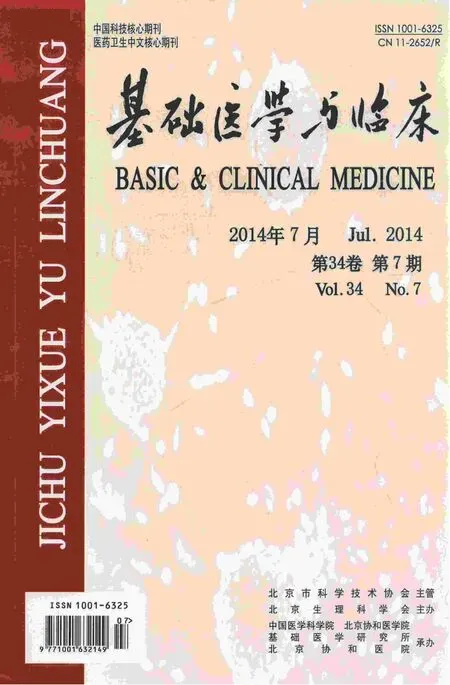慢性阻塞性肺疾病中Sirtuins的研究进展
陈 刚
(解放军第四二五医院 呼吸内科, 海南 三亚 572000)
慢性阻塞性肺疾病中Sirtuins的研究进展
陈 刚*
(解放军第四二五医院 呼吸内科, 海南 三亚 572000)
Sirtuins是第Ⅲ类组蛋白去乙酰化酶,主要成员SIRT1、SIRT6与慢性阻塞性肺疾病(COPD)发病机制有密切关系。SIRT1、SIRT6在COPD患者肺部中表达下调,并通过多种机制调节炎性反应、肺部自噬与衰老。Sirtuins可能是COPD发生过程中的一个调控分子家族。
慢性阻塞性肺病;Sirtuins;SIRT1;SIRT6
慢性阻塞性肺疾病(chronic obstructive pulmonary disease, COPD)是以不完全可逆的气流受限为特征并呈进行性发展的疾病。此病患人数多,死亡率高,社会经济负担重,已成为影响人类健康的重要的公共卫生问题。COPD目前居全球死亡原因的第4位,据世界卫生组织预计,至2020年COPD将位居世界疾病经济负担的第5位。中国的流行病学调查表明,40岁以上人群COPD患病率为8.2%,患病率之高十分惊人。引起COPD的危险因素包括个体易感因素以及环境因素两个方面,两者相互影响[1]。Sirtuins可能是慢性阻塞性肺疾病发生过程中的一个调控分子[2]。然而,目前国内有关Sirtuins相关于COPD发病机制等研究报道较少。本文主要从Sirtuins与COPD关系研究进展进行综述。
1 Sirtuins家族
Sirtuins是近年来发现的第Ⅲ类组蛋白去乙酰化酶,其活性依赖NAD+。Sirtuins主要位于细胞的核仁内,是一种从细菌到人类都高度保守的去乙酰化酶类。人类Sirtuins家族中公认的成员有7个,即SIRT1~7。Sirtuins具有广泛的生物学作用,例如细胞分化、细胞死亡、细胞衰老、代谢、炎性反应、 氧化应激抵抗和转录调控等[3]。与COPD发病机制有密切关系的是SIRT1、SIRT6。国外已有不少的研究证实SIRT1、SIRT6和COPD有着密切的关系,在国内相关的资料尚少。
SIRT1具有调控代谢的功能,主要通过对组蛋白、转录因子及其他蛋白修饰的赖氨酸残基进行去乙酰化,调节基因的表达[4]。其作用底物除组蛋白外,还包括多种非组蛋白如forkhead转录因子(forkhead box O,FOXO)、P53、核因子-κB(nuclear factor kappa B,NF-κB)、内皮型一氧化氮合酶(endothelial nitric oxide synthase,eNOS)、诱导型一氧化氮合酶(induced nitric oxide synthase,iNOS)等,参与调控DNA 修复、细胞凋亡、氧化应激和细胞衰老等多种生理病理过程。
SIRT6是异常染色质相关核蛋白,参与碱基切除修复。SIRT6高表达于大脑和骨骼肌。在体外,它不但具有去乙酰化酶活性,还具有较强的ADP-核糖基转移酶活性[5]。
2 SIRT1和COPD
2.1SIRT1在吸烟人群和COPD患者肺部中表达下调
有报道,烟草中的成分能够下调肺泡巨噬细胞和支气管上皮细胞中SIRT1的表达及活性,从而影响其下游基因的表达,并破坏SIRT1与一些炎性蛋白的相互作用,进而导致COPD的发生发展[6]。在COPD动物模型、COPD患者及吸烟人群肺部也发现SIRT1表达下调[7]。与非吸烟人群相比,吸烟人群和COPD患者肺组织巨噬细胞中SIRT1表达水平降低,P65的乙酰化增强。这可能是因为烟草中的成分使SIRT1发生氧化/亚硝基化等翻译后修饰[8]。
2.2 SIRT1与NF-κB调节促炎性基因表达
香烟诱导的氧化应激反应可以下调SIRT1的表达,进而导致NF-κB和激活蛋白1(activator protein 1,AP-1)乙酰化水平增加,基质金属蛋白酶9(matrix metalloproteinase 9, MMP9)转录活性增强,且这种改变与肺功能损伤的严重程度呈正相关[9]。另外,采用RNA干扰技术抑制人单核细胞系中SIRT1的表达后,香烟介导的NF-κB活性和促炎性介质的释放均有所增加,在SIRT1缺失的转基因小鼠中也证实了这一点[10]。NF-κB通过释放炎性介质,肺部发生慢性炎性反应,在COPD发展过程中是极其重要的[11]。组蛋白乙酰化的增强对引起局部促炎因子的释放起着重要的作用,而SIRT1作为一种重要的蛋白参与到组蛋白的去乙酰化和负性调节NF-κB的活性,从而减少炎性因子的释放[12- 13]。NF-κB是肺上皮细胞的一个启动子,诱导炎性细胞进入肺部,SIRTl通过抑制NF-κB转录达到抗炎目的[14]。
2.3 SIRT1与肺部自噬调节
自噬在香烟诱导的应激反应中扮演重要角色,也可能是导致COPD发病机制之一[15]。香烟介导的氧化应激能诱导肺部自噬的发生,且在SIRT1缺失的转基因小鼠中这种现象更为显著,而SIRT1激动剂白藜芦醇则能减少自噬的发生[16]。此外,PARP-1抑制剂也能通过激活SIRT1而减少香烟诱导的自噬。这些都说明了SIRT1-PARP-1通路在香烟诱导的自噬发生中起着重要的调节作用,可见,SIRT1是肺部自噬的重要调节者。
另外,STRT1和FoxO3相关的信号通路参与对哺乳动物自噬的调节。在体外培养的细胞或者转基因鼠体内,SIRT1能够激活自噬作用,SIRT1/转基因鼠的一些表型和自噬蛋白(autophgy-related gene product, Atg5)/小鼠相似。SIRT1与自噬蛋白Atg5、Atg7和Atg8的去乙酰化有关,表明长寿基因SIRT1和自噬降解过程的相关性。FoxO3能够诱导微管相关蛋白(lignt chain, LC3)和BCL2/腺病毒E1B相互作用蛋白3(Bnip3)等激活自噬活动的蛋白表达,从而促进细胞降解作用,维持生物体的能量代谢[17]。
2.4 SIRT1与肺部衰老
抗衰老分子可能影响衰老过程,并与COPD的发病机制有关。NAD+依赖的组蛋白/蛋白去乙酰化酶在多种病理过程中起关键作用,如应激抵抗、新陈代谢、凋亡、细胞衰老、分化和机体衰老[18]。SIRT1对维持染色质的静默状态是必需的。环境应激(如烟草暴露)使巨噬细胞(在体外)和大鼠肺(在体内)中SIRT1水平下降,同时伴随炎性细胞因子表达增加[8, 19- 20]。COPD患者肺细胞中SIRT1和Ⅱ型组蛋白去乙酰化酶(histone deacetylase,HDAC)亦明显减少[21]。SIRT1具有防止DNA损伤和细胞衰老的功能,沉默毛细血管扩张共济失调突变基因(ataxia telangiectasia mutated,ATM)激酶可以上调SIRT1的表达,减少DNA损伤和细胞衰老[22]。用遗传学方法过表达SIRT1或SIRT1选择性激动剂(SRT1720),证明SIRT1使应激诱导的细胞早衰减轻并使小鼠避免发生吸烟和弹性蛋白酶诱导的肺气肿[23]。这种保护作用与SIRT1使转录因子FOXO3去乙酰化有关,而非抑制NF-κB/IKK2诱导的炎性反应,提示SIRT1通过FOXO3使细胞衰老减少,进而防止COPD的发生,激活SIRT1和HDAC2可能是COPD非常有吸引力的治疗策略。
因此,通过药物干预SIRT1的表达水平及活性可能是改善COPD患者肺部异常炎性反应的重要手段。
3 SIRT6和COPD
SIRT6抑制TGF-β诱导人支气管上皮细胞衰老,SIRT6抗衰老能力主要通过转录P21/waf1退化蛋白[24]。SIRT6在COPD患者肺脏中的表达也同样减少。HDAC-2在COPD患者的周围肺组织及肺泡巨噬细胞中的活性及表达显著下降,进而涉及炎性反应加重及糖皮质激素不敏感。另外,初步研究发现COPD患者肺脏的Klotho及SMP-30水平也出现了下降。SIRT6激活剂是另一种抑制肺脏加速衰老的途径[25]。
4 展望
目前,SIRT1已经成为当前的一个研究热点,已经明确证实SIRT1可通过去乙酰化组蛋白/非组蛋白和一些转录因子的调控,在细胞水平上参与基因的转录调控、DNA损伤修复和细胞凋亡等,维持机体正常的生命活动。虽有研究证实SIRT1和SIRT6与COPD有相关性,但研究都没有与临床的运用相结合,因此, SIRT1和SIRT6若想要作为靶点真正运用到临床疾病的治疗上,仍需进一步深入的研究。
[1] Vestbo J, Hurd SS, Agusti AG,etal. Global strategy for the diagnosis, management, and prevention of chronic obstructive pulmonary disease: GOLD executive summary[J]. Am J Respir Crit Care Med, 2013, 187: 347- 365.
[2] Corbi G, Bianco A, Turchiarelli V,etal. Potential mechanisms linking atherosclerosis and increased cardiovascular risk in COPD: focus on sirtuins[J]. Int J Mol Sci, 2013, 14: 12696- 12713.
[3] Mahajan SS, Leko V, Simon JA,etal. Sirtuin modulators[J]. Handb Exp Pharmacol, 2011, 206: 241- 255.
[4] Haigis MC, Sinclair DA. Mammalian sirtuins: biological insights and disease relevance[J]. Annu Rev Pathol, 2010, 5: 253- 295.
[5] Beauharnois JM, Bolivar BE, Welch JT. Sirtuin 6: a review of biological effects and potential therapeutic properties[J]. Mol Biosyst, 2013, 9: 1789- 1806.
[6] Caito S, Hwang JW, Chung S,etal. PARP-1 inhibition does not restore oxidant-mediated reduction in SIRT1 activity[J]. Biochem Biophys Res Commun, 2010, 392: 264- 270.
[7] Hwang JW, Chung S, Sundar IK,etal. Cigarette smoke-induced autophagy is regulated by SIRT1-PARP-1-dependent mechanism: implication in pathogenesis of COPD[J]. Arch Biochem Biophys, 2010, 500: 203- 209.
[8] Rajendrasozhan S, Yang SR, Kinnula VL,etal. SIRT1, an antiinflammatory and antiaging protein, is decreased in lungs of patients with chronic obstructive pulmonary disease[J]. Am J Respir Crit Care Med, 2008, 177: 861- 870.
[9] Sundar IK, Yao H, Rahman I. Oxidative stress and chromatin remodeling in chronic obstructive pulmonary disease and smoking-related diseases[J]. Antioxid Redox Signal, 2013, 18: 1956- 1971.
[10] Yang SR, Wright J, Bauter M,etal. Sirtuin regulates cigarette smoke-induced proinflammatory mediator release via RelA/p65 NF-kappaB in macrophagesinvitroand in rat lungsinvivo: implications for chronic inflammation and aging[J]. Am J Physiol Lung Cell Mol Physiol, 2007, 292: 567- 576.
[11] Rahman I, Kinnula VL, Gorbunova V,etal. SIRT1 as a therapeutic target in inflammaging of the pulmonary disease[J]. Prev Med, 2012, 54: 20- 28.
[12] Breitenstein A, Stein S, Holy EW,etal. Sirt1 inhibition promotesinvivoarterial thrombosis and tissue factor expression in stimulated cells[J]. Cardiovasc Res, 2011, 89: 464- 472.
[13] Stein S, Schafer N, Breitenstein A,etal. SIRT1 reduces endothelial activation without affecting vascular function in ApoE-/- mice[J]. Aging (Albany NY), 2010, 2: 353- 360.
[14] Yao H, Rahman I. Current concepts on oxidative/carbonyl stress, inflammation and epigenetics in pathogenesis of chronic obstructive pulmonary disease[J]. Toxicol Appl Pharmacol, 2011, 254: 72- 85.
[15] Caito S, Rajendrasozhan S, Cook S,etal. SIRT1 is a redox-sensitive deacetylase that is post-translationally modified by oxidants and carbonyl stress[J]. FASEB J, 2010, 24: 3145- 3159.
[16] Knobloch J, Wahl C, Feldmann M,etal. Resveratrol attenuates the release of inflammatory cytokines from human bronchial smooth muscle cells exposed to lipoteichoic acid in chronic obstructive pulmonary disease[J]. Basic Clin Pharmacol Toxicol, 2013. doi: 10.1111/bcpt.12129.
[17] Lee IH, Cao L, Mostoslavsky R,etal. A role for the NAD-dependent deacetylase Sirt1 in the regulation of autophagy[J]. Proc Natl Acad Sci U S A, 2008, 105: 3374- 3379.
[18] Guarente L. Sirtuins, aging, and metabolism[J]. Cold Spring Harb Symp Quant Biol, 2011, 76: 81- 90.
[19] Schug TT, Xu Q, Gao H,etal. Myeloid deletion of SIRT1 induces inflammatory signaling in response to environmental stress[J]. Mol Cell Biol, 2010, 30: 4712- 4721.
[20] Stein S, Lohmann C, Schafer N,etal. SIRT1 decreases Lox-1-mediated foam cell formation in atherogenesis[J]. Eur Heart J, 2010, 31: 2301- 2309.
[21] Nakamaru Y, Vuppusetty C, Wada H,etal. A protein deacetylase SIRT1 is a negative regulator of metalloproteinase-9[J]. FASEB J, 2009, 23: 2810- 2819.
[22] Paschalaki KE, Starke RD, Hu Y,etal. Dysfunction of endothelial progenitor cells from smokers and COPD patients due to increased DNA damage and senescence[J]. Stem Cells, 2013. doi: 10.1002/stem.1488.
[23] Yao H, Chung S, Hwang JW,etal. SIRT1 protects against emphysema via FOXO3-mediated reduction of premature senescence in mice[J]. J Clin Invest, 2012, 122: 2032- 2045.
[24] Minagawa S, Araya J, Numata T,etal. Accelerated epithelial cell senescence in IPF and the inhibitory role of SIRT6 in TGF-beta-induced senescence of human bronchial epithelial cells[J]. Am J Physiol Lung Cell Mol Physiol, 2011, 300: 391- 401.
[25] Papaioannou AI, Rossios C, Kostikas K,etal. Can we delay the accelerated lung aging in COPD? Anti-aging molecules and interventions[J]. Curr Drug Targets, 2013, 14: 149- 157.
Recent advances of Sirtuins in chronic obstructive pulmonary disease
CHEN Gang*
(Dept. of Respiratory Medicine, the 425th Hospital of People’s Liberation Army, Sanya 572000, China)
Sirtuins are class Ⅲ histone deacetylase. SIRT1 and SIRT6 are the major members of Sirtuins participated in the development of chronic obstructive pulmonary disease(COPD). The expression of SIRT1 and SIRT6 was down-regulated in the lungs of patients with COPD. They regulate inflammatory reaction, lung autophagy and senescence through multiple mechanisms. Sirtuins may be one of major regulatory molecule family in the progression of COPD.
COPD; Sirtuins; SIRT1; SIRT6
2013- 08- 14
2013- 12- 23
*通信作者(correspondingauthor): ch.g_7.12@126.com
1001-6325(2014)04-1010-04
短篇综述
R-1
A

